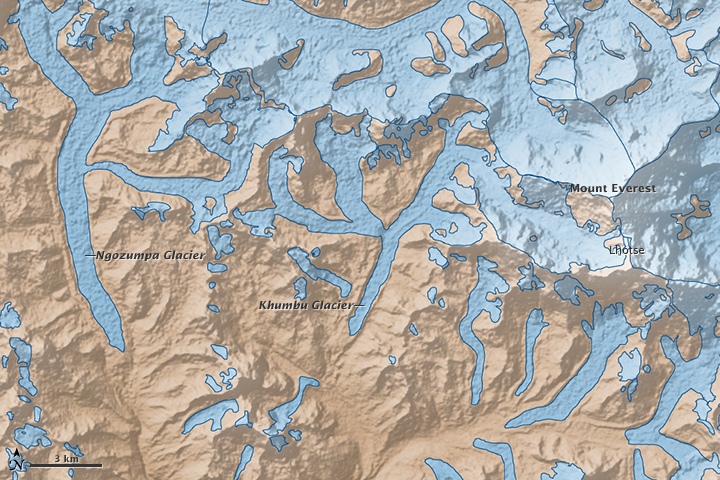NASA: Exploring Mount Everest’s Ice - Khumbu. Ngozumpa glaciers - 08.16.13
Posted by Ricardo Marcenaro | Posted in NASA: Exploring Mount Everest’s Ice - Khumbu. Ngozumpa glaciers - 08.16.13 | Posted on 19:42

acquired November 29, 2005
download large image (2 MB, JPEG, 2502x2388)

acquired August 15, 2009
At 8,848 meters (29,029 feet) above sea level, the summit of Mount Everest,
is arguably the most coveted and infamous bit of land on the planet.
More than 200 climbers have died trying to reach Everest’s summit. But
there’s more to Everest—and the other peaks towering nearby—than the
human quest for the summit. There’s also snow and ice spilling from
knife-edged arêtes and bowl-shaped cirques and becoming frozen rivers of ice as they flow into the valleys below. And there’s science happening at those glaciers.
The map above shows the outlines of glaciers around Everest, overlaid on a topographic map of the region based on digital elevation model (DEM) data from the Advanced Spaceborne Thermal Emission and Reflection Radiometer (ASTER) on NASA’s Terra
satellite. Progressively lighter shades of brown depict higher
elevations of bare land; glaciers are shown with progressively lighter
shades of blue (higher is lighter).
One of the primary glaciers draining Mount Everest and the highest glacier in the world, Khumbu, is visible in the center of the map. Ngozumpa, the longest glacier in the Himalayas, is visible to the west.
Lateral moraines—accumulations
of debris created by rocks tumbling from sheer valley walls—appear as
thin ridges along the edges of both glaciers. The same rockfalls that
produce lateral moraines also coat Himalayan glaciers with thick layers
of rock and debris. This debris interests climatologists and
glaciologists because it can affect how glaciers respond to climate change.
Since glacial debris can be extremely difficult to reach and study in
person, NASA scientist Kimberly Casey has developed new methods to map
the composition of glacial debris via satellite.
Casey knows firsthand how challenging it can be to study glacial
debris. She has visited numerous remote glaciers, including Ngozumpa and
Khumbu, to make measurements that can be compared with satellite
observations. She shot the photograph above while passing through the
Cho La pass, which separates the two glaciers.
To learn more about Casey’s research, read our feature story: “Painted Glaciers.“
Further Reading
- American Geophysical Union (2013, May 13) Scientists find extensive glacial retreat in Mount Everest region. Accessed August 8, 2013.
- National Geographic (2013, June) Maxed Out on Everest. Accessed August 8, 2013.
- GlacierWorks The Glaciers. Accessed August 8, 2013.
- NASA (2012, April 2) Meet Kimberly Casey: Studying How Debris Influences Glaciers. Accessed August 8, 2013.
NASA Earth Observatory image by Robert Simmon, using data from NASA/GSFC/METI/ERSDAC/JAROS, and U.S./Japan ASTER Science Team. Photograph by Kimberly Casey. Caption by Adam Voiland.
- Instrument:
- Terra - ASTER
NASA: Exploring Mount Everest’s Ice - Khumbu. Ngozumpa glaciers - 08.16.13
Ricardo M Marcenaro - Facebook
Blogs of The Solitary Dog:
Solitary Dog Sculptor:
http://byricardomarcenaro.blogspot.com
Solitary Dog Sculptor I:
http://byricardomarcenaroi.blogspot.com
Para:
comunicarse conmigo,
enviar materiales para publicar,
propuestas comerciales:
marcenaroescultor@gmail.com
For:
contact me,
submit materials for publication,
commercial proposals:
marcenaroescultor@gmail.com
Diario La Nación
Argentina
Cuenta Comentarista en el Foro:
Capiscum
My blogs are an open house to all cultures, religions and countries. Be a follower if you like it, with this action you are building a new culture of tolerance, open mind and heart for peace, love and human respect.
Thanks :)
Mis blogs son una casa abierta a todas las culturas, religiones y países. Se un seguidor si quieres, con esta acción usted está construyendo una nueva cultura de la tolerancia, la mente y el corazón abiertos para la paz, el amor y el respeto humano.
Gracias :)


Comments (0)
Publicar un comentario